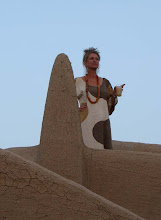
Bamako Bulletin.
A question has been turning over in my mind: should I take the link to my blog off the hotel website?
The other day I got a hotel booking by email which started: ‘ I am really sorry to be disturbing you at this moment of difficulty, but I would really like to book a room on the third of February. Would that be OK?’
Illness and bad luck is hardly what tourists and prospective hotel guests are expecting or want to see when they check this blog out. Sunny stories from an exotic location is of course what people want.
But this blog is not a marketing ploy. I didn’t start the hotel as a ‘career move’. If I had wanted to make money or really be a successful 'hotelier' I would have gone somewhere else. The hotel is my life now, and my life is the way it is. At the moment that includes Keita’s illness.
I have decided to keep the blog link on the hotel website.
But dear prospective hotel guest, please do not feel that you are intruding: We want you to come, and you will not have to be personally involved in any of this stuff. Just keep drinking those sunset cocktails on our roof and enjoy the hotel- that is what we want you to do! And in any case, until the 6th of Febuary you will only run into my friend Birgit at the hotel, and she is of excellent health.
Keita and I seem interminably delayed in Bamako. If we are not waiting for test results to come through, we are waiting for medication to be sent from overseas, and now we are waiting for Monday to start taking this new medication, because today it is too soon for Keita to start a new course of Chemotherapy, which should be done in combination with the new drug. On Monday we will still have to wait until Wednesday in order to make sure there are no bad side effects to the new treatment.
Within evil there is always good somewhere. Look at the drug Keita is about to start taking on Monday: it is the evil old drug Thalidomide which caused 10000 babies to be born with horrific malformations in the early sixties. It is now THE only effective drug to treat Keita’s disease, Multiple Myeloma. We went through a series of contortions to find this drug which is not available in Mali. Teams of friends were researching the pharmaceutical suppliers of their respective countries, which included Switzerland, Ireland, Sweden, the United States and the UK. Strangely, the easiest place to get hold of the stuff was Sweden which we had assumed to be the hardest. But it would have been ten times as expensive as in the UK, whence it finally winged its way here courtesy of Federal Express.
Keita has deteriorated further. He has lost almost all use of his legs and cannot walk anymore- even with the help of friends holding him up either side. Today we bought a wheelchair for him. This will make things easier practically speaking but of course, symbolically, it is very difficult. The idea that he is now in a wheelchair is hard to digest. Some of the time he is very angry, raging against what is happening to him, but most of the time he patient and trying to be positive.
This has happened to him so fast- just over six weeks ago he started to have some inkling that there was something wrong. Now he has to come to terms with perhaps being lame. Although it has not been spoken of, of course he knows there is a possibility he will never walk again. Our minds are amazingly adaptable, and we acclimatize ourselves to our changing circumstances. Yesterday he made me cry by saying: ‘if only I could walk just a little, it would be fine’.
Otherwise I don’t cry and I am feeling strangely unemotional. Perhaps I am just practical too- what is the use of crying? Having said that, I seem to cry a lot at certain songs, but they have to be extremely simple. I just have to hear KarKar (Boubakar Traore) sing- just about anything actually, but in particular I TARA SANTA MARIYA I KA MARIAM FO N’YE ( when you go to Santa Maria, send my greetings to Mariam) and I am in floods of tears- not to speak of his ‘Adieu Pierrette,’ his farewell on the death of his toubab wife.
We have moved out of the Colibris and we are staying with my friend Ann, a Belgian girl who runs Tounga Tours, a successful Malian travel agency, with her Malian husband Van. We sit on their verandah, play cards, talk about hotel business sometimes, I draw Keita and read books- things I have not had the time to do for years. Keita is listening to an amazing collection of music we just found on my laptop. I vaguely remember a kind tourist at the hotel last year – it must have been someone who stayed at the hotel after the Music festival at Essakane. He copied a whole lot of stuff on to my laptop, which I promptly forgot all about until yesterday. Anyway it is amazing stuff- mainly ‘world Music’ for want of a better label. Someone called Mariam Hassan- possibly Moroccan; the ‘Baobab Orchestra’; ‘Transglobal Underground’ and by far the best of all: a snippet of about 4 minutes of something entitled ‘Origins of Guitar Music in Southern Congo and Northern Zambia, 1950’ Absolutely fantastic.







